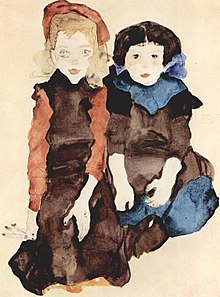'World War I now began to shape Schiele's life and work. Three days after his wedding, Schiele was ordered to report for active service in the army, he was initially stationed in Prague. In the army, Schiele was treated well by officers who respected his artistic talent. He never saw any fighting at the front, and was able to continue painting and sketching while guarding Russian prisoners of war, and doing light guard duties. By 1917, he was back in Vienna, able to focus on his artistic career. His output was prolific, and his work reflected the maturity of an artist in full command of his talents. He was invited to participate in the Secession's 49th exhibition, held in Vienna in 1918. Schiele had fifty works accepted for this exhibition, and they were displayed in the main hall. He also designed aposter for the exhibition, which was reminiscent of the Last Supper, with a portrait of himself in the place of Christ. The show was a triumphant success, and as a result, prices for Schiele's drawings increased and he received many portrait commissions.
Schiele participated in numerous group exhibitions, including those of the Neukunstgruppe in Prague in 1910 andBudapest in 1912; the Sonderbund, Cologne, in 1912; and several Secessionist shows in Munich, beginning in 1911. In 1913, the Galerie Hans Goltz, Munich, mounted Schiele's first solo show. A solo exhibition of his work took place in Paris in 1914.
In the autumn of 1918, the Spanish flu epidemic that claimed more than 20,000,000 lives in Europe reached Vienna. Edith, who was six months pregnant, succumbed to the disease on 28 October. Schiele died only three days after his wife. He was 28 years old. During the three days between their deaths, Schiele drew a few sketches of Edith; these were his last works.'


No comments:
Post a Comment